 |
 |
.
|
.
.
 |
 |
 |
| . |
|
History of Jerusalem and
How to solve Palestine problem
|
|
-
.
|

|
| This
Web Page contains following information. |
.
.
| . |
Index Section
|
Click Below Link
|
 |
1) Vedic Sastra has answer for Palestinian, Israel problem.  |
 |
 |
2) Biblical times: History of Jerusalem (Palestine).  |
 |
 |
3) Changes in Israeli-Palestinian area
map.  |
 |
|
|
 |
|
|
 |
| 1) Vedic Sastra
has answer for Palestinian, Israel problem. |
-
| 1) Do you know what really happened from "Prophet Abraham (Prophet Ibraheem)
time" to 1250BC in Israel
and Palestinians places?
2) Do you know why Jews faces and Palestinians Muslims faces
looks similar and different from rest of the world? (Forget about skin
color, hair color and eye color)
3) Palestinians Muslims faces looks different from Muslims faces
of other places but faces and skull shape similar to Jews faces.. Do you
know why? Soon you will know.
4) There is solution exist in "Vedic Sastra"
for "Palestinians Muslims and Jews problem".
Soon I let you know, first read below history information you will
know who is wrong in Muslims and Jews problem.
5) Problem between Israel and Palestinians Muslims is not major
problem it is all about illegal weapon trade. If this problem doesnít exist
how Middle East countries Govt. and Terrorist people buy illegal weapons
from illegal market? Illegal market organizations are prolonging this problem
for their income. Without country Govt permission Illegal weapon donít
come from Manufactured country border. As you know rich countries making
weapons, they are getting huge amount of money from Middle East countries
Govt. and Terrorist people that is the reason world wide people are calling
rich countries. Middle East countries Govt getting money (income) from
oil fields but paying that money back rich countries by buying illegal
weapons, So who are getting fool? Donít you think Muslims?
One country trading illegal weapons, What is that country? I will give
you one clue, find out your self. There are many terrorist organizations
exists in all over the world but only one terrorist organization not getting
illegal weapons because that terrorist organization located in that country
where that country is controlling illegal weapon sale. That is the reason
that country's terrorist organization not getting illegal weapons but other
terrorist organizations in other country getting illegal weapons. Guess
it that country name? Note: I donít write without any evidence OK.
.
|
| .. |
- |
 |
|
|
 |
| 2) Biblical
times: History of Jerusalem (Palestine). |
-
.

|
Jew man and Palestinian Muslim man face
.
Ancient times The land that now encompasses Israel and the Palestinian
territories has been conquered and re-conquered throughout history.
Details of the ancient Israelite states are sketchy, derived for the
most part from the first books of the Bible and classical history. Some
of the key events include:
Note: Eastern world people don't know what is Jews.. Jews are
people same as muslims
.
"Jews"
are people whose religion is "Judaism".
"Muslims"
are people whose religion is "Islam".
Both religions have close relationship with "Prophet Abraham"
also called "Prophet Ibraham"! |
 |
1250BC- 638AD
.
.
1250 BC: Israelites began to conquer and settle the land
of Canaan on the eastern Mediterranean coast.
961-922 BC: Reign of King Solomon and construction of
the Temple in Jerusalem. Solomon's reign was followed by the division of
the land into two kingdoms.
586 BC: The southern kingdom, Judah, was conquered by the Babylonians,
who drove its people, the Jews, into exile and destroyed Solomon's Temple.
After 70 years the Jews began to return and Jerusalem and the temple were
gradually rebuilt.
Classical period
333 BC: "Alexander the Great"
conquest brought the area under Greek rule.
165 BC: A revolt in Judea established the last independent
Jewish state of ancient times.
63 BC: The Jewish state, Judea, was incorporated into
the Roman province of Palestine
70 AD: A revolt against Roman rule was put down by the
Emperor Titus and the Second Temple was destroyed. This marks the beginning
of the Jewish Diaspora, or dispersion.
118-138 AD: During the Roman Emperor Hadrian's rule,
Jews were initially allowed to return to Jerusalem, but - after another
Jewish revolt in 133 - the city was completely destroyed and its people
banished and sold into slavery.
638 AD: Conquest by Arab Muslims ended Byzantine rule
(the successor to Roman rule in the East). The second caliph of Islam,
Omar, built a mosque at the site of what is now the al-Aqsa Mosque in Jerusalem
in the early years of the 8th Century. Apart from the age of the Crusaders
(1099-1187), the region remained under Muslim rule until the fall of the
"Ottoman Empire"
in the 20th Century. |
 |
1897 First Zionist Congress
.
.
The "First Zionist Congress"
met in Basle, Switzerland, to discuss the ideas set out in Theodor Herzl's
1896 book Der Judenstaat ("The Jewish State").
Herzl, a Jewish journalist and writer living in Vienna, wanted Jews to
have their own state - primarily as a response to European anti-Semitism.
The Congress issued the Basle Programme to establish a "home for the
Jewish people in Palestine secured by public law" and set up the World
Zionist Organisation to work for that end.
A few Zionist immigrants had already started arriving in the area before
1897. By 1903 there were some 25,000 of them, mostly from Eastern Europe.
They lived alongside about half a million Arab residents in what was then
part of the Turkish Ottoman Empire. A second wave of about 40,000 immigrants
arrived in the region between 1904 and 1914. |
 |
1917 "Shifting
sands"
.
.
At the time of World War I the area was ruled by the Turkish Ottoman
empire. Turkish control ended when Arab forces backed by Britain drove
out the Ottomans.
Britain occupied the region at the end of the war in 1918 and was assigned
as the mandatory power by the "League of Nations"
on 25 April 1920.
During this period of change, three key pledges were made.
In 1916 the British Commissioner in Egypt, Sir Henry McMahon, had promised
the Arab leadership post-war independence for former Ottoman Arab provinces.
However, at the same time, the secret Sykes-Picot Agreement between
war victors, Britain and France, divided the region under their joint control.
Then in 1917, the British Foreign Minister Arthur Balfour committed
Britain to work towards "the establishment in Palestine of a national home
for the Jewish people", in a letter to leading Zionist Lord Rothschild.
It became known as the Balfour Declaration. |
 |
1929-36 Arab discontent
.
.
The Zionist project of the 1920s and 1930s saw hundreds of thousands
of Jews emigrating to British Mandate Palestine, provoking unrest in the
Arab community.
In 1922, a British census showed the Jewish population had risen to
about 11% of Palestine's 750,000 inhabitants. More than 300,000 immigrants
arrived in the next 15 years.
Zionist-Arab antagonism boiled over into violent clashes in August 1929
when 133 Jews were killed by Palestinians and 110 Palestinians died at
the hands of the British police.
Arab discontent again exploded into widespread civil disobedience during
a general strike in 1936. By this time, the militant Zionist group Irgun
Zvai Leumi was orchestrating attacks on Palestinian and British targets
with the aim of "liberating" Palestine and Transjordan (modern-day Jordan)
by force.
In July 1937, Britain, in a Royal Commission headed by former Secretary
of State for India, Lord Peel, recommended partitioning the land into a
Jewish state (about a third of British Mandate Palestine, including Galilee
and the coastal plain) and an Arab one.
Palestinian and Arab representatives rejected this and demanded an end
to immigration and the safeguarding of a single unified state with protection
of minority rights. Violent opposition continued until 1938 when it was
crushed with reinforcements from the UK. |
 |
1947 UN partition of Palestine
.
.
Britain, which had ruled Palestine since 1920, handed over responsibility
for solving the Zionist-Arab problem to the UN in 1947.
The territory was plagued with chronic unrest pitting native Arabs against
Jewish immigrants (who now made up about a third the population, owning
about 6% of the land). The situation had become more critical with the
displacement of hundreds of thousands of Jews fleeing the Nazi persecution
in Europe. Some six million Jews were killed in the Holocaust during World
War II.
The UN set up a special committee which recommended splitting the territory
into separate Jewish and Palestinian states. Palestinian representatives,
known as the Arab Higher Committee, rejected the proposal; their counterparts
in the Jewish Agency accepted it.
The partition plan gave 56.47% of Palestine to the Jewish state and
43.53% to the Arab state, with an international enclave around Jerusalem.
On 29 November 1947, 33 countries of the UN General Assembly voted for
partition, 13 voted against and 10 abstained. The plan, which was rejected
by the Palestinians, was never implemented.
Britain announced its intention to terminate its Palestine mandate on
15 May 1948 but hostilities broke out before the date arrived.
The death of British soldiers in the conflict made the continuing presence
in Palestine deeply unpopular in Britain. In addition, the British resented
American pressure to allow in more Jewish refugees - a sign of growing
US suport for Zionism.
Both Arab and Jewish sides prepared for the coming confrontation by
mobilising forces. The first "clearing" operations were conducted against
Palestinian villages by Jewish forces in December. |
 |
1948 Establishment of Israel
.
.
The State of Israel, the first Jewish state for nearly 2,000 years,
was proclaimed at 1600 on 14 May 1948 in Tel Aviv. The declaration came
into effect the following day as the last British troops withdrew. Palestinians
remember 15 May as "al-Nakba", or the Catastrophe.
The year had begun with Jewish and Arab armies each staging attacks
on territory held by the other side. Jewish forces, backed by the Irgun
and Lehi militant groups made more progress, seizing areas alloted to the
Jewish state but also conquering substantial territories allocated for
the Palestinian one.
Irgun and Lehi massacred scores of inhabitants of the village of Deir
Yassin near Jerusalem on 9 April. Word of the massacre spread terror among
Palestinians and hundreds of thousands fled to Lebanon, Egypt and the area
now known as the West Bank.
The Jewish armies were victorious in the Negev, Galilee, West Jerusalem
and much of the coastal plain.
The day after the state of Israel was declared five Arab armies from
Jordan, Egypt, Lebanon, Syria and Iraq immediately invaded Israel but were
repulsed, and the Israeli army crushed pockets of resistance. Armistices
established Israel's borders on the frontier of most of the earlier British
Mandate Palestine.
Egypt kept the Gaza Strip while Jordan annexed the area around East
Jerusalem and the land now known as the West Bank. These territories made
up about 25% of the total area of British Mandate Palestine. |
 |
1964 Formation of the PLO
.
.
Since 1948 there had been fierce competition between neighbouring states
to lead an Arab response to the creation of Israel. That left the Palestinians
as passive onlookers.
In January 1964, Arab governments - wanting to create a Palestinian
organisation that would remain essentially under their control - voted
to create a body called the "Palestine Liberation Organisation (PLO)".
But the Palestinians wanted a genuinely independent body, and that was
the goal of Yasser Arafat who took over the chairmanship of the PLO in
1969. His Fatah organisation (founded in secret five years earlier) was
gaining notoriety with its armed operations against Israel.
"Fatah fighters"
inflicted heavy casualties on Israeli troops at Karameh in Jordan in 1968. |
 |
1967 The 1967 War
.
.
Mounting tensions between Israel and its Arab neighbours culminated
in six days of hostilities starting on 5 June 1967 and ending on 11 June
- six days which changed the face of the Middle East conflict.
Israel seized Gaza and the Sinai from Egypt in the south and the Golan
Heights from Syria in the north. It also pushed Jordanian forces out of
the West Bank and East Jerusalem.
Egypt's powerful air force was put out of action on the first day of
fighting when Israeli jets bombed it on the ground in a pre-emptive strike.
The territorial gains doubled the area of land controlled by Israel.
The victory heralded a new age of confidence and optimism for Israel and
its supporters.
The UN issued Security Council Resolution 242, stressing "the inadmissibility
of the acquisition of territory by war" and calling for "withdrawal of
Israeli armed forces from territories occupied in the recent conflict".
According ot the UN, the conflict displaced another 500,000 Palestinians
who fled to Egypt, Syria, Lebanon and Jordan. |
 |
1973 The 1973 "Yom
Kippur war"
.
.
Unable to regain the territory they had lost in 1967 by diplomatic
means, Egypt and Syria launched major offensives against Israel on the
Jewish festival of the Day of Atonement or Yom Kippur. The clashes are
also known as the Ramadan war.
Initially, Egypt and Syria made advances in Sinai and the Golan Heights.
These were reversed after three weeks of fighting. Israel eventually made
gains beyond the 1967 ceasefire lines.
Israeli forces pushed on into Syria beyond the Golan Heights, though
they later gave up some of these gains. In Egypt, Israeli forces regained
territory and advanced to the western side of the Suez Canal.
The United States, the Soviet Union and the United Nations all made
diplomatic interventions to bring about ceasefire agreements between the
combatants.
Egypt and Syria jointly lost an estimated 8,500 soldiers in the fighting,
while Israel lost about 6,000.
The war left Israel more dependent on the US for military, diplomatic
and economic support. Soon after the war, Saudi Arabia led a petroleum
embargo against states that supported Israel. The embargo, which caused
a steep rises in petrol prices and fuel shortages across the world, lasted
until March 1974. In October 1973 the UN Security Council passed resolution
338 which called for the combatants "to cease all firing and terminate
all military activity immediately... [and start] negotiations between the
parties concerned under appropriate auspices aimed at establishing a just
and durable peace in the Middle East". |
 |
1974 Arafat's first UN appearance
.
.
In the 1970s, under "Yasser Arafat's"
leadership, PLO factions and other militant Palestinian groups such as
Abu Nidal launched a series of attacks on Israeli and other targets.
One such attack took place at the Munich Olympics in 1972 in which 11
Israeli athletes were killed.
But while the PLO pursued the armed struggle to "liberate all of Palestine",
in 1974, Arafat made a dramatic first appearance at the United Nations
mooting a peaceful solution.
He condemned the Zionist project, but concluded: "Today I have come
bearing an olive branch and a freedom fighter's gun. Do not let the olive
branch fall from my hand."
The speech was a watershed in the Palestinians' search for international
recognition of their cause.
A year later, a US State Department official, Harold Saunders, acknowledged
for the first time that "the legitimate interests of the Palestinian Arabs
must be taken into account in the negotiating of an Arab-Israeli peace". |
 |
1977 Israel's resurgent right wing
.
.
Hardline Irgun and Lehi groups may have been instrumental in the creation
of Israel in 1948, but their heirs in the Herut (later Likud) party failed
to win an Israeli election until 1977.
Until this time Israeli politics had been dominated by the left-wing
Labour Party. Likud ideology focused on extending Israeli sovereignty in
the whole of the earlier Britsh Mandate Palestine, as well as claiming
Jordanian territory as part of the "Greater Israel of Biblical times".
The new government, led by former Irgun leader Menachem Begin, intensified
Israeli settlement activity in the West Bank and Gaza with a view to creating
"facts on the ground" to prevent any future territorial compromise over
the areas captured in 1967.
Agriculture minister Ariel Sharon spearheaded this movement as chairman
of the ministerial committee for settlements until 1981. |
 |
1979 Israel and Egypt make peace
.
.
Egyptian President Anwar Sadat stunned the world by flying to the Jewish
state and making a speech to the Israeli parliament in Jerusalem on 19
November 1977.
Sadat became the first Arab leader to recognise Israel, only four years
after launching the October 1973 war (known as the Yom Kippur war in Israel).
The war was indecisive after Egypt and Syria had attacked Israeli forces
occupying Sinai and the Golan Heights. It ended with the issuing of UN
Resolution 338 calling for "a just and durable peace in the Middle East".
Egypt and Israel signed the Camp David accords in September 1978 outlining
"the framework for peace in the Middle East" which included limited autonomy
for Palestinians. A bilateral Egyptian-Israeli peace treaty was signed
by Sadat and Israeli Prime Minister Menachem Begin six months later in
March 1979.
The Sinai Peninsula, which Israel had seized in the 1967 war, was returned
to Egypt.
Arab states boycotted Egypt for breaking ranks and negotiating a separate
treaty with Israel.
Sadat was assassinated in 1981 by Islamist elements in the Egyptian
army, who opposed peace with Israel, during national celebrations to mark
the anniversary of the October war. |
 |
1982 Israel invades Lebanon
.
.
The Israeli army launched a massive military incursion into Lebanon
in the summer of 1982. Operation "Peace for Galilee"
was intended to wipe out Palestinian guerrilla bases near Israel's northern
border, although Defence Minister Ariel Sharon pushed all the way to Beirut
and expelled the PLO from the country.
The invasion began on 6 June, less than two months after the last Israeli
troops and civilians were pulled out of Sinai under the 1979 treaty with
Egypt. The action was triggered by the attempt on the life of Israeli ambassador
to London Shlomo Argov by the dissident Palestinian group Abu Nidal.
Israeli troops reached Beirut in August. A ceasefire agreement allowed
the departure of PLO fighters from Lebanon, leaving Palestinian refugee
camps defenceless.
As Israeli forces gathered around Beirut on 14 September, Bashir Gemayel,
leader of the Christian Phalange militia, was killed by a bomb at his HQ
in the capital. The following day, the Israeli army occupied West Beirut.
From 16 to 18 September, the Phalangists - who were allied to Israel
- killed hundreds of Palestinians in the Sabra and Shatila refugee camps
as they were encircled by Israeli troops in one of the worst atrocities
of nearly a century of conflict in the Middle East. Mr Sharon resigned
from his post as defence minister after a 1983 Israeli inquiry concluded
that he had failed to act to prevent the massacre. |
 |
1987 Palestinian intifada
.
.
A mass uprising - or intifada - against the Israeli occupation began
in Gaza and quickly spread to the West Bank.
Protest took the form of civil disobedience, general strikes, boycotts
on Israeli products, graffiti, and barricades, but it was the stone-throwing
demonstrations against the heavily-armed occupation troops that captured
international attention.
The Israeli Defence Forces responded and there was heavy loss of life
among Palestinian civilians. More than 1,000 died in clashes which lasted
until 1993. |
 |
1988 PLO opens door to peace
.
.
Despite its military might, Israel was unable to quell the intifada
which started in 1987 and was backed by the entire Palestinian population
living under Israeli occupation.
For the PLO - based in Tunis since its expulsion from Lebanon in 1982
- the uprising threatened the loss of its role as the main player in the
Palestinian "revolution" as focus shifted to the occupied territories and
away from the diaspora population.
The Palestinian National Council (a government-in-exile) convened in
Algeria in November 1988 and voted to accept a "two-state" solution based
on the 1947 UN partition resolution (181), renounce terrorism and seek
a negotiated settlement based on Resolution 242, which called for Israel
to withdraw from territory captured in the 1967 war, and Resolution 338.
The US began dialogue with the PLO. But Israel continued to view the
PLO as a terrorist organisation with which it would not negotiate. Instead,
Israeli Prime Minister Yitzhak Shamir proposed elections in the occupied
territories before negotiations on a self-rule agreement. |
 |
1991 Madrid Summit
.
.
The 1991 Gulf War was a disaster for the PLO and its leader Yasser
Arafat whose support for Iraq alienated his wealthy supporters in the Gulf.
With Kuwait liberated from Iraqi control, the US administration devoted
itself to Middle East peacemaking - a prospect more appealing to the financially
weakened and politically isolated Arafat than Israel's hard-line Likud
prime minister Yitzhak Shamir.
Numerous visits by the US Secretary of State James Baker prepared the
ground for an international summit in Madrid. Syria agreed to attend, hoping
to negotiate a return of the Golan Heights. Jordan also accepted the invitation.
But Shamir refused to talk directly with PLO "terrorists", so a joint
Jordanian-Palestinian delegation was formed with prominent Palestinian
figures- who were not from the PLO - taking part. In the days before the
summit, Washington withheld $10bn of loan guarantees from Israel in a rare
moment of discord over the building of Jewish settlements in the occupied
territories.
A worldwide audience watched the historic summit begin on 30 October.
The old enemies were each given 45 minutes to set out their positions.
The Palestinians spoke of a shared future of hope with Israel, Shamir justified
the existence of the Jewish state, while Syrian Foreign Minister Farouq
al-Shara dwelled on Mr Shamir's "terrorist" past.
After the summit the US set up separate bilateral meetings in Washington
between Israel and Syria, and with the Jordanian-Palestinian delegations. |
 |
1993 The Oslo Peace Process
.
.
The election of the left-wing Labour government in June 1992, led by
Yitzhak Rabin, triggered a period of frenetic Israeli-Arab peacemaking
in the mid-1990s.
The government - including the "iron-fisted" Rabin and doves Shimon
Peres and Yossi Beilin - was uniquely placed to talk seriously about peace
with the Palestinians. The PLO, meanwhile, wanted to make peace talks work
because of the weakness of its position due to the Gulf War.
Israel immediately lifted a ban on PLO participants in the stalemated
bilateral meetings in Washington. More significantly Foreign Minister Peres
and his deputy Beilin explored the possibility of activating a secret forum
for talks facilitated by Norway.
With the Washington bilateral talks going nowhere, the secret "Oslo
track" - opened on 20 January 1993 in the Norwegian town of Sarpsborg -
made unprecedented progress. The Palestinians consented to recognise Israel
in return for the beginning of phased dismantling of Israel's occupation.
Negotiations culminated in the Declaration of Principles, signed on
the White House lawn and sealed with a historic first handshake between
Rabin and Yasser Arafat watched by 400 million people around the world. |
 |
1994 Birth of the Palestinian Authority
.
.
On 4 May 1994 Israel and the Palestinian Liberation Organisation reached
an agreement in Cairo on the initial implementation of the 1993 Declaration
of Principles. This document specified Israel's military withdrawal from
most of the Gaza Strip, excluding Jewish settlements and land around them,
and from the Palestinian town of Jericho in the West Bank. Negotiations
were difficult and were almost derailed on 25 February when a Jewish settler
in the West Bank town of Hebron fired on praying Muslims, killing 29 people.
The agreement itself contained potential pitfalls. It envisaged further
withdrawals during a five-year interim period during which solutions to
the really difficult issues were to be negotiated - issues such as the
establishment of a Palestinian state, the status of Jerusalem, Jewish settlements
in the Occupied Territories and the fate of more than 3.5 million Palestinian
refugees from the 1948 and 1967 upheavals.
Many critics of the peace process were silenced on 1 July as jubilant
crowds lined the streets of Gaza to cheer Yasser Arafat on his triumphal
return to Palestinian territory. The returning Palestinian Liberation Army
deployed in areas vacated by Israeli troops and Arafat became head of the
new Palestinian National Authority (PA) in the autonomous areas. He was
elected president of the Authority in January 1996. |
 |
1995 Oslo II and the assassination
of Rabin
.
.
The first year of Palestinian self-rule in Gaza and Jericho was dogged
by difficulties. Bomb attacks by Palestinian militants killed dozens of
Israelis, while Israel blockaded the autonomous areas and assassinated
militants. Settlement activity continued. The Palestinian Authority quelled
unrest by mass detentions. Opposition to the peace process grew among right-wingers
and religious nationalists in Israel.
Against this background, peace talks were laborious and fell behind
schedule. But on 24 September the so-called Oslo II agreement was signed
in Taba in Egypt, and countersigned four days later in Washington.
The agreement divided the West Bank into three zones:
Zone A comprised 7% of the territory (the main Palestinian towns
excluding Hebron and East Jerusalem) going to full Palestinian control;
Zone B comprised 21% of the territory under joint Israeli-Palestinian
control;
Zone C stayed in Israeli hands. Israel was also to release Palestinian
prisoners. Further handovers followed.
Oslo II was greeted with little enthusiasm by Palestinians, while Israel's
religious right was furious at the "surrender of Jewish land". Amid an
incitement campaign against Israeli Prime Minister Yitzhak Rabin, a Jewish
religious extremist assassinated him on 4 November, sending shock waves
around the world. The dovish Shimon Peres, architect of the faltering peace
process, became prime minister. |
 |
1996-99 Deadlock
.
.
Conflict returned early in 1996 with a series of devastating suicide
bombings in Israel carried out by the Islamic militant group Hamas, and
a bloody three-week bombardment of Lebanon by Israel.
Peres narrowly lost elections on 29 May to the right-wing Binyamin "Bibi"
Netanyahu, who campaigned against the Oslo peace deals under the motto
"Peace with Security".
Netanyahu soon enflamed Arab opinion by lifting a freeze on building
new settlements in the occupied territories and provoking fears about undermining
Muslim holy sites in Jerusalem by opening an archaeological tunnel under
the compound of al-Aqsa mosque - one of Islam's holiest sites.
Despite his antagonism towards the existing peace process, Netanyahu,
under increasing US pressure, handed over 80% of Hebron in January 1997
and signed the Wye River Memorandum on 23 October 1998 outlining further
withdrawals from the West Bank.
But his right-wing coalition collapsed in January 1999 in disarray over
the implementation of the Wye deal. He lost elections on 18 May to Labour's
Ehud Barak who pledged to "end the 100-year conflict" between Israel and
the Arabs within one year.
The five-year interim period defined by Oslo for a final resolution
passed on 4 May 1999, but Yasser Arafat was persuaded to defer unilateral
declaration of Palestinian statehood to give a chance for negotiations
with the new administration. |
 |
2000 Second intifada
.
.
Initial optimism about the peacemaking prospects of a government led
by Ehud Barak proved unfounded. A new Wye River accord was signed in September
1999 but further withdrawals from occupied land were hindered by disagreements
and final status talks (on Jerusalem, refugees, settlements and borders)
got nowhere. Frustration was building in the Palestinian population who
had little to show for five years of the peace process.
Barak concentrated on peace with Syria - also unsuccessfully. But he
did succeed in fulfilling a campaign pledge to end Israel's 21-year entanglement
in Lebanon.
After the withdrawal from Lebanon in May 2000, attention turned back
to Yasser Arafat, who was under pressure from Barak and US President Bill
Clinton to abandon gradual negotiations and launch an all-out push for
a final settlement at the presidential retreat at Camp David. Two weeks
of talks failed to come up with acceptable solutions to the status of Jerusalem
and the right of return of Palestinian refugees.
In the uncertainty of the ensuing impasse, Ariel Sharon, the veteran
right-winger who succeeded Binyamin Netanyahu as Likud leader, toured the
al-Aqsa/Temple Mount complex in Jerusalem on 28 September. Sharon's critics
saw it as a highly provocative move. Palestinian demonstrations followed,
quickly developing into what became known as the al-Aqsa intifada, or uprising. |
 |
2001 Sharon returns
.
.
By the end of 2000 Israeli Prime Minister Ehud Barak found himself
presiding over an increasingly bitter and bloody cycle of violence as the
intifada raged against Israel's occupation in the West Bank and Gaza.
With his coalition collapsing around him, Barak resigned as prime minister
on 10 December to "seek a new mandate" to deal with the crisis. However
in elections on 6 Febuary, Ariel Sharon was swept to power by an Israeli
electorate that had overwhelmingly turned its back on the land-for-peace
formulas of the 1990s and now favoured a tougher approach to Israel's "Palestinian
problem".
The death toll soared as Sharon intensified existing policies such as
assassinating Palestinian militants, air strikes and incursions into Palestinian
self-rule areas. Palestinian militants, meanwhile, stepped up suicide bomb
attacks in Israeli cities.
The US spearheaded international efforts to calm the violence. Envoy
George Mitchell led an inquiry into the uprising, while CIA director George
Tenet negotiated a ceasefire - but neither initiative broke the cycle of
bloodshed. |
 |
2002-03 West Bank re-occupied
.
.
After waves of suicide attacks early in the year, Israel re-occupied
almost all of the West Bank in March, and again in June. For most of 2002,
Palestinian cities were regularly raided, remained cut off from each other,
surrounded and under curfew for long periods of time.
In April, Israeli forces entered and captured the refugee camp in northern
West Bank city of Jenin. The Palestinians claimed massacre. The Israeli
army, which took heavy casualties, said it met heavy organised resistance,
and insisted that 52 Palestinians were killed.
A UN report criticised both sides for "violence that placed civilians
in harm's way", and concluded that there was no massacre of civilians.
A report by the human rights group Amnesty International concluded however
that that the Israeli army had committed war crimes during its incursions
into the West Bank towns of Jenin and Nablus.
In May, a five-week standoff at Bethlehem's Church of the Nativity ended
when 13 Palestinian militants were sent into exile. A large group of Palestinians
had taken refuge in the church when Israeli troops moved into the town.
Israeli officials said the operations in the West Bank and Gaza throughout
2002 were aimed at destroying the Palestinian terrorist infrastructure.
Through the year, suicide attacks continued, though at a reduced rate.
For the second year running the peace process was in deep freeze. The
Quartet, the United States, Russia, the United Nations and the European
Union tried to revive it with the "roadmap" for Middle East settlement.
The publication of the document was delayed by wrangling over its contents
in 2002. Diplomatic initiatives were put on hold until after the US-led
war in Iraq in April 2003 when the roadmap was published.
In June, President George Bush made a long-anticipated statement on
the Middle East. He called for Palestinians to replace their leader with
one not "compromised by terror". |
|
| .. |
|
 |
| 3)
Changes in Israeli-Palestinian area map |
-
--
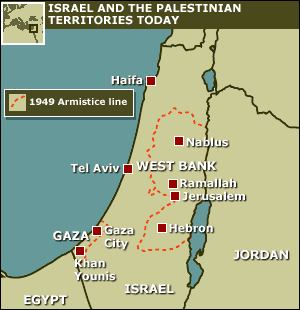 |
Introduction
At the heart of the Israeli-Palestinian conflict is a dispute over land
and borders. The geography of the conflict revolves around the three territorial
units of Israel, the West Bank and Gaza, defined by armistice lines drawn
after a war in the region in 1948. Since then, military action, settlement
and population growth have also shaped the situation on the ground.
BBC News Online explores the conflict by comparing maps of the region
over time |
| - |
- |
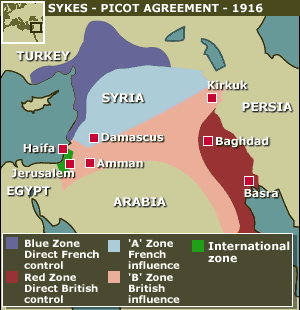 |
British control: Sykes-Picot
The "Sykes-Picot agreement"
was a secret understanding concluded in 1916 between Great Britain and
France, with the assent of Russia, for the dismemberment of the Ottoman
Empire. The agreement was not implemented, but it established the principles
for the division a few years later of the Turkish-held region into the
French and British-administered areas of Syria, Iraq, Lebanon and Palestine. |
| - |
- |
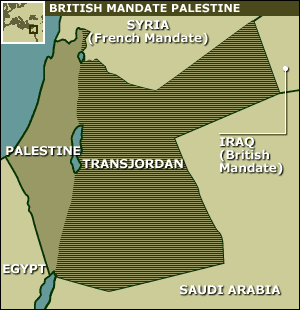 |
British control: Mandate Palestine
Palestine - comprising what are now Israel, the West Bank, Gaza Strip and
Jordan - was among several former Ottoman Arab territories placed under
the administration of Great Britain by the League of Nations. The mandate
lasted from 1920 to 1948. In 1923 Britain granted limited autonomy to Transjordan,
now known as Jordan. |
| - |
- |
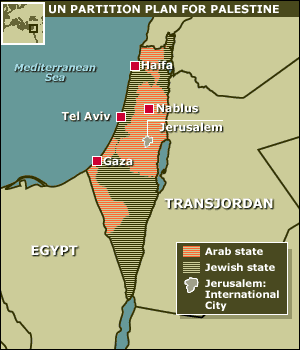 |
Israel founded: UN partition plan
The United Nations General Assembly decided in 1947 on the partition of
Palestine into Jewish and Arab states, with Jerusalem to be an international
city. The plan, which was rejected by the native Arabs, was never implemented. |
| - |
- |
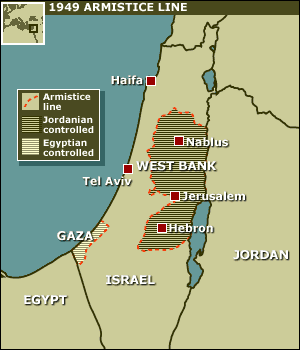 |
Israel founded: Armistice
War broke out in 1948 when Britain withdrew, the Jews declared the state
of Israel and troops from neighbouring Arab nations moved in. After eight
months of fighting an armistice line was agreed, establishing the West
Bank and Gaza Strip as distinct geographical units. |
| - |
- |
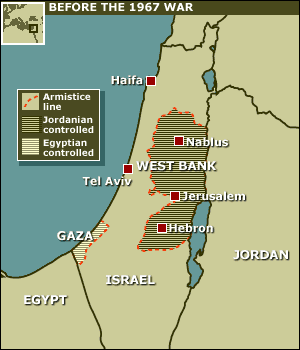 |
Six-Day War: Before the war
From 1948 to 1967, the West Bank, including East Jerusalem, was ruled by
Jordan. During this period, the Gaza Strip was under Egyptian military
administration. Israeli troops captured Egypt's Sinai peninsula during
the 1956 British, French and Israeli military campaign in response to the
nationalisation of the "Suez Canal".
The Israelis subsequently withdrew and were replaced with a UN force. In
1967, Egypt ordered the UN troops out and blocked Israeli shipping routes
- adding to already high levels of tension between Israel and its neighbours. |
| - |
- |
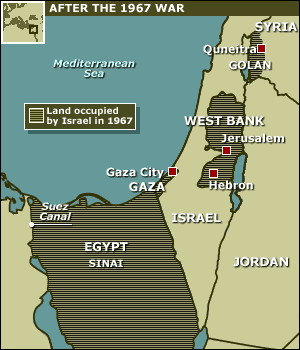 |
Six-Day War: After the war
In a pre-emptive attack on Egypt that drew Syria and Jordan into a regional
war in 1967, Israel made massive territorial gains capturing the West Bank,
Gaza Strip, Golan Heights and the Sinai Peninsula up to the Suez Canal.
The principle of land-for-peace that has formed the basis of Arab-Israeli
negotiations is based on Israel giving up land won in the 1967 war in return
for peace deals recognising Israeli borders and its right to security.
The Sinai Peninsula was returned to Egypt as part of the 1979 peace deal
with Israel. |
| - |
- |
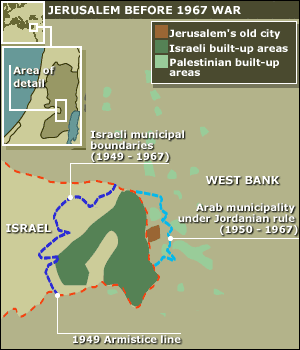 |
Jerusalem: Before 1967
The armistice line drawn at the end of the 1948 war divided Jerusalem into
two. Between 1949 and 1967, Israel controlled the western part of Jerusalem,
while Jordan took the eastern part, including the old walled city containing
important Jewish, Muslim and Christian religious sites. |
| - |
- |
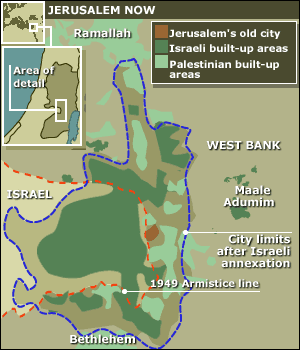 |
Jerusalem: After 1967
Israel captured the whole of Jerusalem in 1967 and extended the city's
municipal boundaries, putting both East and West Jerusalem under its sovereignty
and civil law. In 1980 Israel passed a law making its annexation of East
Jerusalem explicit. The city's status remains disputed, with Israel's occupation
of East Jerusalem considered illegal under international law. Israel is
determined that Jerusalem be its undivided capital, while Palestinians
are seeking to establish their capital in East Jerusalem. |
| - |
- |
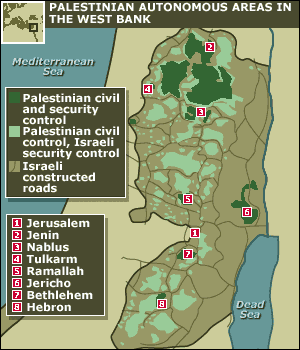 |
West Bank: Palestinian-controlled areas
Since the 1993 Declaration of Principles resulting from the Oslo peace
process, there have been several handovers of land to differing degrees
of Palestinian control. Currently 59% of the West Bank is officially under
Israeli civil and security control. Another 23% of it is under Palestinian
civil control, but Israeli security control. The remainder of the territory
is governed by the Palestinian National Authority - although such areas
have been subject to Israeli incursions during the recent intifada. |
| - |
- |
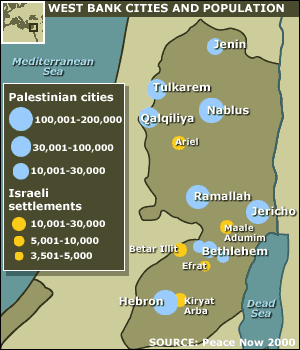 |
West Bank: Population centres
The areas of Palestinian Authority control are mainly located in Palestinian
urban areas Ė the population centres where much of the fast-growing population
lives. These take up about 8.5% of the West Bank. About 2.3 million Palestinians
live in the West Bank, together with about 400,000 Israeli settlers - including
those who live in East Jerusalem. About 6.7 million people live in Israel,
of whom about 1.3 million are Israeli Arabs. |
| - |
- |
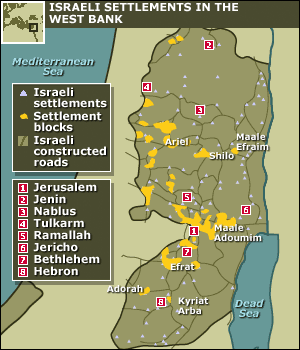 |
West Bank: Israeli settlements
Since 1967, Israel has pursued a policy of building settlements on the
West Bank. These cover about 2% of the area of the West Bank and are linked
by Israeli-controlled roads. There are also large tracts of Israeli-controlled
land designated as military areas or nature reserves. |
| - |
- |
 |
West Bank: Israeli settlements
Since 1967, Israel has pursued a policy of building settlements on the
West Bank. These cover about 2% of the area of the West Bank and are linked
by Israeli-controlled roads. There are also large tracts of Israeli-controlled
land designated as military areas or nature reserves
. |
| - |
- |
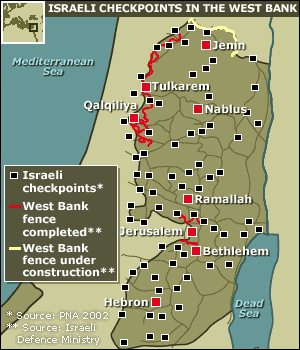 |
West Bank: Israeli checkpoints
Military checkpoints on West Bank roads allow Israel to monitor and control
travel in much of the West Bank. During the recent Palestinian intifada,
Israeli troops have also encircled and staged incursions into population
centres and severely restricted the movement of Palestinian civilians.
In 2002, Israel began building a security barrier near the north-western
edge of the West Bank. |
| - |
- |
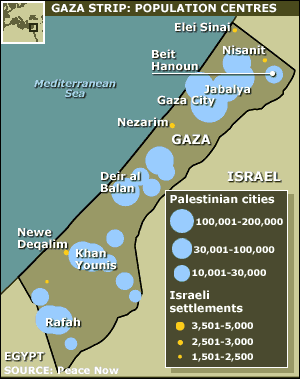 |
Gaza Strip: Population
Gaza, one of the most densely populated tracts of land in the world, is
home to about 1.3m Palestinians, about 33% of whom live in United Nations-funded
refugee camps. Gaza is also home to about 8,000 Jewish settlers. |
| - |
- |
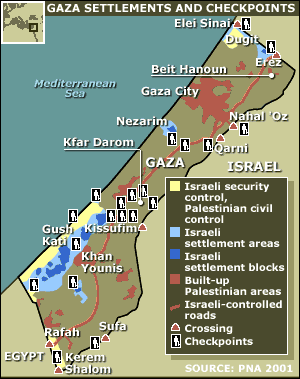 |
Gaza Strip: Settlements and security
Israeli settlement areas cover about 15% of the Gaza Strip. Israel controls
all external borders and crossing points and some roads in Gaza.
|
|
| .. |
|
 |
| 4) Vedic Sastra has answer for Palestinian,
Israel problem. |
- -
| 1) Do you know what really happened from Prophet Abraham (Prophet Ibraheem)
time to 1250BC in Israel and Palestinians places?
2) Do you know why Jews faces and Palestinians Muslims faces
looks similar and different from rest of the world? (Forget about skin
color, hair color and eye color)
3) Palestinians Muslims faces looks different from Muslims faces
of other places but faces and skull shape similar to Jews faces.. Do you
know why? Soon you will know.
4) There is solution exist in "Vedic Sastra"
for Palestinians Muslims and Jews problem. "Bible",
"Koran", Jewish
holy books says World Ends and then "Judgement days"
starts. After Judgement days ends what is going to happen? These things
not written in Bible, Koran and Jewish holy books but something written
in Hindu holy book Vedic Sastra. Vedic Sastra says After End Of World (I
mean after end of "Kali Yuga")
Judgement days starts, after Judgement days world restart again. The New
World also called Satya Yuga. So in last World Jews used to stay in "Jerusalem
(Israel)" but
After last Judgement Days God removed all religions. As you know what is
the point keeping religions after Judgement Days. Even Muslims know Isa
(Jesus Second Come) removes all religions in Judgement days. So what you
think Palestine Muslims were Jews in Last world. I mean to say Jews and
Palestine Muslims are belongs to same Blood, that is the reason Jews faces
and Palestine Muslims faces almost same compared to other faces in the
world. When Jews and Palestine Muslims know that both are belongs to same
blood than do they still fight each other?
5) Problem between Israel and Palestinians Muslims is not major
problem it is all about illegal weapon trade. If this problem doesnít exist
how Middle East countries Govt. and Terrorist people buy illegal weapons
from illegal market? Illegal market organizations are prolonging this problem
for their income. Without country Govt permission Illegal weapon donít
come from Manufactured country border. As you know rich countries making
weapons, they are getting huge amount of money from Middle East countries
Govt. and Terrorist people that is the reason world wide people are calling
rich countries. Middle East countries Govt getting money (income) from
oil fields but paying that money back rich countries by buying illegal
weapons, So who are getting fool? Donít you think Muslims?
One country trading illegal weapons, What is that country? I will give
you one clue, find out your self. There are many terrorist organizations
exists in all over the world but only one terrorist organization not getting
illegal weapons because that terrorist organization located in that country
where that country is controlling illegal weapon sale. That is the reason
that country's terrorist organization not getting illegal weapons but other
terrorist organizations in other country getting illegal weapons. Guess
it that country name? Note: I donít write without any evidence OK.
6) Muslims believe four Holy book, those Holy book are "Koran",
"Engile", "Thorath" and "Zaboor". What Muslims following now is "Koran".
Holy book "Engile" is nothing but Bible, "Thorath" is nothing but Jews
Holy book. But non of Muslims know what is "Zaboor" holy book, where this
book exist? and How many pages this book contains? The question is Does
"Zaboor" has answer for Palestinians Muslims and Jews problem? If any
one donít find answer for question in one holy book then they try to look
answer for your question in other holy book.
.
.
|
| .. |
- |
 |
|
Payment Option
|
.
Dear Visitors,
.
Subject:
Payment option to keep www.swastik.org alive.
.
Content of this website is free for people who
canít afford to pay payment $2
(Two Dollar) for other they need to pay money $2 (Two Dollar) for
every once in a month. This is non-profitable Organization my profession
breaking code in Holy Books and publish it. The amount that I get from
people will be used to maintain my Website, Bandwidth, other expenditure.
Donít pay more then $2 dollar. This is not charity organization.
.
Use Below button for Payment option
.
.
Now You are able reading this website that means
some body payed $2 for this website. One Giga bytes bandwidth cost $1
+ USA Tax.
Using one Giga bytes bandwidth nearly 1000 visitors can see complete
my website.
.
Regards,

Second Come of Jesus (Bible)
Kalki Avatar (Hindu Holy Book).
Hazrat Isa Asalam (Koran)
.
Note: If any company wants to pay my website maintenance for one year then contact my web hosting company and pay amount and tell them to email me. I keep your company advertisement in special page for one year. Website maintenance includes infinite bandwidth high-speed server. As you know this www.swastik.org would have millions of hits per Second.
.
 |
 |
 |
| . |
Personal
Advertisement
|
.. |
 |
 |
 |
|
|
 |
|
-
- |
|
.. |
 |
 |
 |
.
. |
. | |
 |  |
 |